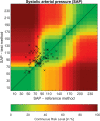Oscillometric versus invasive blood pressure measurement in patients with shock: a prospective observational study in the emergency department
- PMID: 32056094
- PMCID: PMC8514358
- DOI: 10.1007/s10877-020-00482-2
Oscillometric versus invasive blood pressure measurement in patients with shock: a prospective observational study in the emergency department
Erratum in
-
Correction to: Oscillometric versus invasive blood pressure measurement in patients with shock: a prospective observational study in the emergency department.J Clin Monit Comput. 2022 Feb;36(1):287. doi: 10.1007/s10877-021-00766-1. J Clin Monit Comput. 2022. PMID: 34652625 Free PMC article. No abstract available.
Abstract
In emergency medicine, blood pressure is often measured by an oscillometric device using an upper arm cuff. However, measurement accuracy of this technique in patients suffering from hypotensive shock has not been sufficiently evaluated. We designed a prospective observational study investigating the accuracy of an oscillometric device in hypotensive patients admitted to the resuscitation area of the emergency department. Patients admitted to the resuscitation area of a university hospital, who were equipped with an arterial catheter and found to be hypotensive (mean arterial pressure (MAP) < 60 mmHg) were eligible for the study. Blood pressure was measured simultaneously via upper arm cuff and invasively under routine clinical conditions. After data extraction, Bland-Altman analysis, correlation coefficient and percentage error of mean and systolic blood pressure pairs were performed. We analysed 75 simultaneously obtained blood pressure measurements of 30 patients in hypotension, 11 (37%) were female, median age was 76.5 years (IQR 63-82). Oscillometric MAP was markedly higher than invasive MAP with a mean of the differences of 13 ± 15 mmHg (oscillometric-invasive), 95% limits of agreement - 16 to 41 mmHg, percentage error was 76%. In 64% of readings, values obtained by the upper arm cuff were not able to detect hypotension. Oscillometric blood pressure measurement is not able to reliably detect hypotension in emergency patients. Therefore, direct measurement of blood pressure should be established as soon as possible in patients suffering from shock.
Keywords: Emergency medicine; Hypotension; Oscillometric blood pressure; Resuscitation area; Shock.
Conflict of interest statement
All authors declare that they have no conflict of interest.
Figures





References
-
- Cecconi M, De Backer D, Antonelli M, Beale R, Bakker J, Hofer C, Jaeschke R, Mebazaa A, Pinsky MR, Teboul JL, Vincent JL, Rhodes A. Consensus on circulatory shock and hemodynamic monitoring. Task force of the European Society of Intensive Care Medicine. Intensive Care Med. 2014;40(12):1795–815. doi: 10.1007/s00134-014-3525-z. - DOI - PMC - PubMed
-
- von Elm E, Altman DG, Egger M, Pocock SJ, Gotzsche PC, Vandenbroucke JP, Initiative S. The strengthening the reporting of observational studies in epidemiology (STROBE) statement: guidelines for reporting observational studies. Lancet. 2007;370(9596):1453–7. doi: 10.1016/S0140-6736(07)61602-X. - DOI - PubMed
-
- Rhodes A, Evans LE, Alhazzani W, Levy MM, Antonelli M, Ferrer R, Kumar A, Sevransky JE, Sprung CL, Nunnally ME, Rochwerg B, Rubenfeld GD, Angus DC, Annane D, Beale RJ, Bellinghan GJ, Bernard GR, Chiche JD, Coopersmith C, De Backer DP, French CJ, Fujishima S, Gerlach H, Hidalgo JL, Hollenberg SM, Jones AE, Karnad DR, Kleinpell RM, Koh Y, Lisboa TC, Machado FR, Marini JJ, Marshall JC, Mazuski JE, McIntyre LA, McLean AS, Mehta S, Moreno RP, Myburgh J, Navalesi P, Nishida O, Osborn TM, Perner A, Plunkett CM, Ranieri M, Schorr CA, Seckel MA, Seymour CW, Shieh L, Shukri KA, Simpson SQ, Singer M, Thompson BT, Townsend SR, Van der Poll T, Vincent JL, Wiersinga WJ, Zimmerman JL, Dellinger RP. Surviving sepsis campaign: international guidelines for management of sepsis and septic shock: 2016. Intensive Care Med. 2017;43(3):304–77. doi: 10.1007/s00134-017-4683-6. - DOI - PubMed
-
- Salmasi V, Maheshwari K, Yang D, Mascha EJ, Singh A, Sessler DI, Kurz A. Relationship between intraoperative hypotension, defined by either reduction from baseline or absolute thresholds, and acute kidney and myocardial injury after noncardiac surgery: a retrospective cohort analysis. Anesthesiology. 2017;126(1):47–65. doi: 10.1097/ALN.0000000000001432. - DOI - PubMed
Publication types
MeSH terms
LinkOut - more resources
Full Text Sources
Medical

